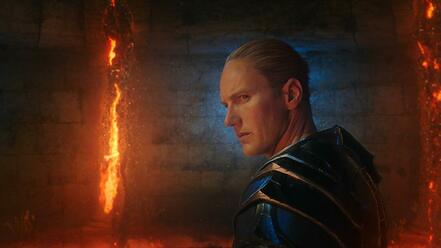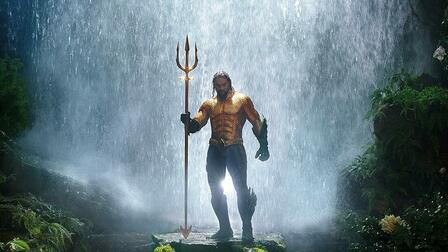Written by Scott Murray THIS IS THE EMERGENCY SPOILER ALERT SYSTEM...YOU ARE ADVISED TO READ AT YOUR OWN RISK... Aquaman helps show us a shift in the presentation of how to deal with evil in the world of comics and comic characters. If I wanted to talk about morality in film, I could take some time to praise Aquaman for presenting relevant environmental issues but not beating us over the head with them. They talk about the problem, but it doesn’t feel preachy. However, that’s not why I’m here. I’m here to talk about the shift we’ve seen in the way major Hero films are treating their villains. Sure, world-ending monsters of pure, inhuman evil are still around, but many villains have become more relatable, more sympathetic, and more real. They might be more accurately described as antagonists, rather than villains. In Aquaman, our main antagonist Prince Orm uses the environmental problems created by humans as one of his (many) arguments to justify war with the surface world, but as the film progresses, we find that he is personally motivated less by the environment or by any concrete grievance and more by his own emotional anger, especially surrounding his mother and the existence of Arthur. Orm undoubtedly loved his mother, but she was cast away by the people of Atlantis to what surely seemed to be her death, all because she dared to tolerate, to consort with, and even to love a surface-dweller. Adding this to the fact that the surface-marriage was one of love, and not arrangement, and that she had another child, an older child, a child who she loved dearly, and Prince Orm lost sight of her teachings of unity as they were buried by his, frankly rather understandable, jealousy and hatred over the child he thought she loved more, who he also blamed for her death. His grief, his anger, his jealousy, all of these things were sharpened into a hatred for ‘the surface dwellers.’ And this is understandable; indeed, Arthur actually shares many of Prince Orm’s feelings, blaming himself - Arthur feels his very existence is at fault, for their mother’s apparent death, just as Prince Orm does. They both feel that their mother might have been better off if she had never fallen in love with a surface-dweller, and never had a ‘half-breed mongrel’ child. Painting Prince Orm’s motivations as understandable isn’t entirely new – sympathetic villains have a long history. But how Arthur deals with him at the end of the movie is relatively new, especially on the scale of a huge, comic-inspired film like Aquaman, and it reflects the changing social factors of our time. In the past, hatred was something easily caricatured, easily laughed at, easily dismissed. Villains were often literal or proverbial Nazis, whose point of view was never something to be taken seriously as a real-life possibility. There was the understanding that it had happened in the past, of course, and the acknowledgement that it wasn’t impossible for it to return in the future, but there was this general presumption that it would not, and an act of distancing ourselves from such terrible deeds. A collective sense that ‘Oh, sure, it’s possible, but nobody who can actually think would really do that.’ Real-world events have revealed to us, often painfully, that this is not the case. That people can and do believe these awful things, and carry out actions that are harmful to others, or sometimes downright villainous. What’s more, our outright dismissal of their ideas and feelings as ‘fictional hyperbole’ has only served to make them more determined, and to bring them together more resolutely in their desire to be taken seriously. In rejecting them, both consciously and unconsciously, they have withdrawn into their feeling of being ostracized from society and doubled down in their opinions, and found solace in others who share their ideas, creating tight-knit and rather sizeable communities of their own, determined to act, to be noticed, to be taken seriously and acknowledged.  A new approach has been needed – not one of dismissal, but one of education, conversation, collaboration, and understanding. When someone holds a hateful opinion, we must work not to dismiss them, to paint them in a villainous and inhuman light, thus ignoring their humanity and increasing and expanding their hatred, but instead try to affirm them as a participant in the society and to educate and discuss with them. When people feel valued by a society, they are more likely to listen, to learn, and to integrate. When they feel rejected or ostracized, they cease to communicate, and instead create their own little feedback loop of the ideas for which they were ostracized in the first place, thus increasing the magnitude of the problem. Welcoming and embracing people with such strong ideas can be difficult to do, but only by opening ourselves to them do we create the opportunity for reconciliation and change. Film and comics are both large influential media, and act both as a reflection of society and a subtle guiding hand. When these are combined into the expansive and far-reaching comic-book-movie, their impact becomes even greater still. Thankfully, there are those in the industries who realize their influence. Take, for example, the Superman posters teaching children that Americans are made up of people of many different races, religions, and national origins, and even goes so far as to say that talking against someone because of these things is Un-American. Published during the height of the Red Scare, this was a serious and powerful message. Aquaman harkens back to these ideals. The most on-the-nose line is probably: ‘A King fights for his nation, but a Hero fights for everyone.’ However, Aquaman has a more precise presentation in the film’s climax and Arthur’s treatment of Prince Orm. Instead of some faceless, unfathomable evil bent on destruction and hellfire, like the Steppenwolf of Justice League or the Loki-led army of Avengers, Prince Orm is a real person with feelings and thoughts that we can see and feel, and instead of simply lopping off his head and consigning him to the wastebasket of history, Arthur spares his life and even reaches out a hand of reconciliation and help. As Prince Orm is led off a prisoner, Arthur says to him ‘Brother, when you’re ready, let’s talk.’ We’ve seen this change reflected in Marvel movies, too. Black Panther in particular comes to mind: the lesson King T’Challa takes from Warmonger is one of outreach and help, rather than one of fear and isolation. He sees how his father’s angry punishment of Warmonger’s father created resentment and anger and fueled a desire for vengeance that led to Warmonger’s violent mindset and attack on Wakanda. Certainly, more and more of our hero stories are taking a more nuanced approach to their antagonists. They are presenting more realistic enemies, who are to be helped or listened to, rather than blindly slaughtered or swept under the rug. Whether you view media as either a driver of social change or a reflection of it, this is good news, because it shows that our influences are driving us towards, (or we are already becoming,) a world with more acceptance, tolerance, patience, and empathy. And no matter how you slice it, that’s a future to look forward to.
1 Comment
5/29/2022 10:51:34 pm
You there, this is really good post here. Thanks for taking the time to post such valuable information. Quality content is what always gets the visitors coming.
Reply
Leave a Reply. |
Archives
December 2024
|
|
© 2012-2025, Nerds That Geek LLC.
All Rights Reserved. |
uWeb Hosting by FatCow

